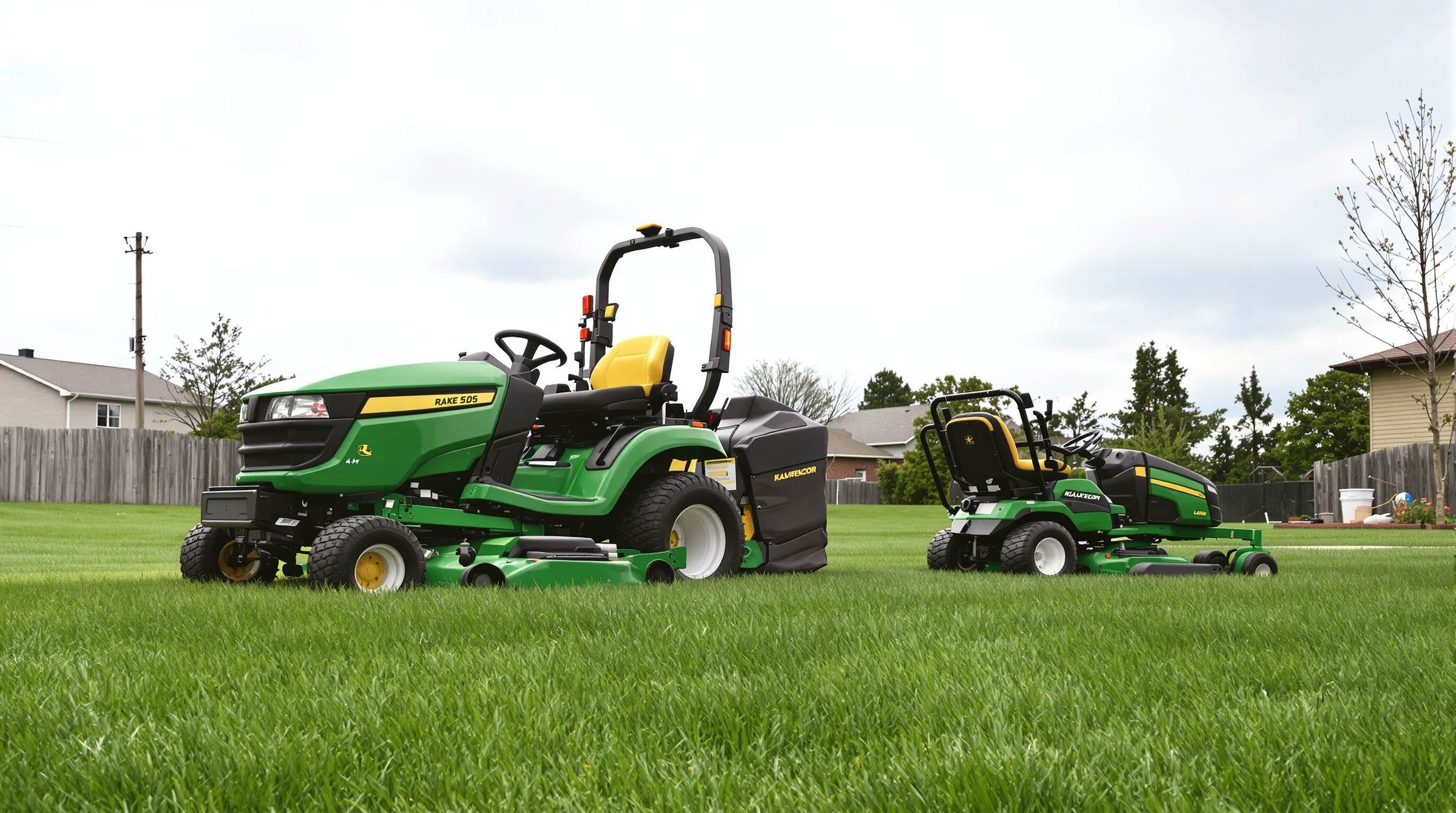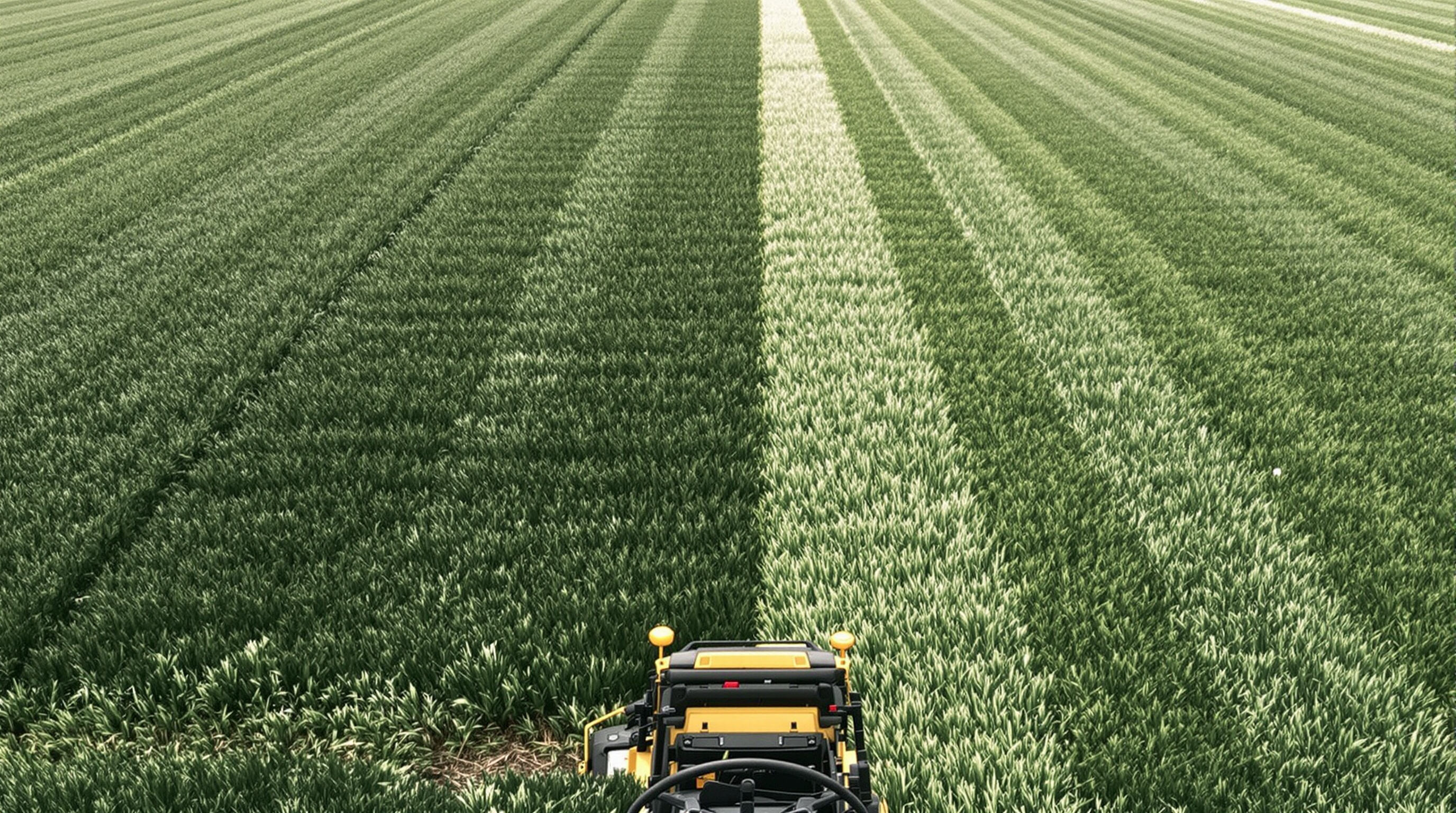Save Time with Faster Coverage on Ride On Mower Lawns

Why walk-behind mowers struggle with large lawn mowing time
Walk-behind mowers typically require 3.5–4 hours to maintain a 1-acre lawn, according to turf management studies. Their narrow 21-inch cutting decks necessitate repetitive, overlapping passes that reduce efficiency—especially on larger properties. Physical strain from pushing the equipment also leads to 15–20 minutes of rest breaks per acre, further slowing progress.
How ride on mowers increase efficiency through higher coverage rates
Ride on mowers today can cover ground about half to two thirds faster than older models because they come with much wider cutting decks ranging from 42 to 72 inches, plus they operate at speeds between 5 and 8 miles per hour. The result? These machines can tackle around 2 to 2.5 acres each hour, while traditional walk behind mowers struggle with just 0.5 to 0.75 acres in the same time frame. For those working on larger properties, commercial quality units with hydrostatic transmissions really make a difference. They keep performing reliably even when tackling slopes as steep as 15 degrees, which means workers don't lose precious time fighting against the machine on uneven land throughout the day.
Case study: Mowing a 2-acre property in half the time
A 2023 field test compared mowing performance on identical 2-acre plots:
| Metric | Walk-Behind | Ride On Mower |
|---|---|---|
| Total Time | 4h 10m | 2h 05m |
| Fuel Consumption | 1.2 gal | 0.9 gal |
| Turns Required | 227 | 89 |
The ride-on's 54-inch deck and zero-turn radius reduced unnecessary overlaps by 41%, demonstrating how proper equipment selection significantly improves efficiency.
Optimize your mowing route using ride-on mower speed and deck size
Maximize efficiency with this proven mowing pattern:
- Cut the perimeter first, using the full reach of the deck overhang
- Make long, straight passes parallel to the longest boundary
- Minimize 180° turns by using the mower's tightest turning radius
- Alternate mowing directions weekly to prevent soil compaction and rutting
Premium models with GPS guidance systems automate route planning, reducing navigation errors by 63% compared to manual operation.
Growing demand for time-efficient lawn care in suburban estates
According to the latest National Lawn Care Survey for 2024, around three out of four homeowners who have at least one acre of property are putting their time above the initial cost of equipment when it comes to lawn maintenance. We're seeing this shift reflected in the market too, with ride-on mower sales climbing by about 22% each year. Suburban neighborhoods seem to be leading this change, as folks there typically devote roughly six and a half hours every week just tending to their lawns. To meet this growing demand, companies have started rolling out different payment plans that let regular customers access equipment normally reserved for professionals. This makes sense given how much time people are spending on their yards these days.
Maximize Cutting Efficiency with Wider Deck Sizes

How Wider Cutting Decks Reduce Overlap and Improve Efficiency
Bigger cutting decks mean fewer backtracking passes and better lawn coverage overall. According to research from ASABE in 2022, when comparing 60 inch versus 42 inch models, the wider ones cut down on overlapping areas by about 40%. That translates into quicker mowing sessions with less need for those frustrating U-turns around obstacles. For folks dealing with properties larger than an acre, smaller decks actually end up wasting roughly a quarter of total mowing time just going over the same ground repeatedly. The good news is manufacturers have addressed this issue through reinforced steel frames ranging between 7 to 10 gauge thickness, plus carefully aligned blades that deliver neat uniform cuts across all deck sizes including the widest options available today.
Performance Comparison: 42-Inch vs. 60-Inch Deck on a 1-Acre Lawn
| Deck Size | Mowing Time | Fuel Consumption | Cut Uniformity |
|---|---|---|---|
| 42-inch | 2.5 hours | 1.2 gallons | 85% consistency |
| 60-inch | 1.6 hours | 0.8 gallons | 93% consistency |
Turf professionals confirm that 60-inch decks complete 1-acre lawns 35% faster while using 33% less fuel. With only 14 passes needed versus 22 for 42-inch decks, soil compaction is also reduced.
Balancing Large Deck Size with Maneuverability Challenges
The 72 inch cutting decks work great when there's plenty of space to maneuver, but get pretty tricky when navigating around garden beds or other landscape features. Most commercial quality riding mowers these days come equipped with anti scalp rollers and floating deck technology, something found in about 3 out of 4 units actually. These features help big decks handle hills and bumps without tearing up the grass underneath. When working in tighter spots though, it makes sense to look at models with articulated steering instead. The straight frame designs tend to scalp lawns quite a bit more often, roughly double what happens with flexible frames on rough terrain according to field tests.
Top Ride On Mowers for Large Yards with Adjustable Cutting Systems
Advanced models offer adaptable cutting systems for diverse property types:
- Variable-speed blade engagement maintains optimal RPM across varying grass densities
- Multi-level deck suspension reduces vibration by up to 50% on rough terrain
- Modular attachment points allow quick swaps between 54-inch and 72-inch decks in under 15 minutes
These features enable one machine to efficiently handle both 2-acre estates and 5-acre recreational fields.
Improve Operator Comfort During Extended Mowing
Ergonomic Design Reduces Physical Fatigue on Large Lawns
Operator comfort gets a real boost with ride on mowers thanks to their ergonomic designs. Sitting down instead of pushing around those walk behind models takes all the strain off legs after a long day's work. And most models come with adjustable steering columns so folks can find whatever sitting position works best for them. Traditional mowers pass along about 90% of ground vibrations straight to whoever's operating them according to Landscape Equipment Journal from last year. But newer ride on versions have rubber mounted seats plus suspension axles that soak up between 60 and 75 percent of those annoying mechanical shocks. Makes a world of difference when cutting grass across rough terrain all morning.
Ride On Mower vs. Walk-Behind: Comparing Operator Strain
Kinetic studies show that walk-behind operators experience 3.2× higher spinal compression during turns than ride-on users. Standing mowing sessions exceeding 90 minutes increase injury risk by 34% (National Lawn Safety Council), whereas ride-on models support neutral spine alignment, reducing lower back muscle activation by 41%.
Key Comfort Features: Suspension Seats, Armrests, and Intuitive Controls
Leading models incorporate comfort-enhancing features such as:
- 4-stage suspension seats with 360° lumbar support adjustments
- Pivoting armrests for natural elbow positioning during steering
- Backlit control panels to reduce eye strain in low-light conditions
As noted in the Commercial Mowing Ergonomics Report, these innovations reduce operator fatigue by 57% during 4-hour mowing sessions compared to basic models.
Navigate Large Properties with Superior Maneuverability
Zero-Turn Ride On Mowers for Speed and Precision in Tight Spaces
Tests from last year show that zero turn riding mowers can cut down lawn maintenance time by about 60% when compared to older models with traditional steering systems. What makes these machines so efficient? They have those special front axles that let them make turns with radius less than 12 inches. This means operators can easily maneuver around obstacles like trees, flower beds, and patios without having to constantly reverse direction. The tight turning capability really helps avoid those frustrating scalped spots and patchy coverage that often happen when using walk behind mowers in smaller yards or tricky landscapes.
Handling Obstacles on 3-Acre Estates with Agile Ride-On Mowers
Equipped with hydrostatic transmissions and adjustable speed settings (1–8 mph), modern ride on mowers efficiently navigate densely landscaped properties. Operators report 47% fewer course corrections when working around play structures, ponds, and rock formations. Four-wheel steering systems maintain traction on slopes up to 15 degrees while protecting sensitive planting zones.
Real-World Test: 30% Less Turning Time on Complex Landscapes
A 12-month study of 45 suburban properties found that ride on mowers complete trimming near fences and garden edges 30% faster than conventional models. This translates to 18 minutes saved per acre in landscapes with eight or more obstacles. Reduced turning frequency also lowers fuel consumption by 22% during typical mowing sessions.
Expand Functionality with Versatile Attachments and Long-Term Value
Ride on mowers become much more useful when equipped with various attachments like mulching kits, baggers, tow bars, and seasonal accessories that extend their functionality throughout the seasons. The best models can handle upwards of ten different attachments, and most owners tend to grab at least three or four seasonal tools during the course of a year. What makes this so convenient is the quick connect system that lets operators switch from mulching in spring to clearing snow in winter without needing any special training or instruction manuals lying around.
Practical example: Leaf collection and light hauling with one machine highlights this versatility. Operators can attach a 15-bushel catcher to clear 1.5 acres of leaves in 45 minutes, then switch to a utility cart for transporting mulch or tools—all with the same machine.
All-year use: Switch from mowing to snow removal with compatible kits extends equipment value. Cold-climate users report 67% annual cost savings by using heated cab enclosures and polyethylene plows instead of standalone snowblowers.
Durability and ROI: 8–12 year lifespan of commercial-grade ride on mowers ensures long-term value with proper maintenance. Industrial-grade steel decks and commercial engines require 40% fewer repairs than residential models, with average annual maintenance costs of $220—significantly less than the $590 average for multiple walk-behind units.
FAQ
Q1: How much time can a ride-on mower save compared to a walk-behind mower?
A1: A ride-on mower can mow 2 to 2.5 acres in an hour compared to 0.5 to 0.75 acres for a walk-behind mower, effectively cutting total mowing time in half.
Q2: Are there any additional benefits to using wider cutting decks?
A2: Yes, wider cutting decks reduce overlap, thus increasing efficiency. A 60-inch deck can complete a 1-acre lawn 35% faster while requiring fewer passes.
Q3: What features contribute to operator comfort in ride-on mowers?
A3: Ride-on mowers come with ergonomic designs, suspension seats, and intuitive controls, reducing physical fatigue and providing a comfortable mowing experience.
Q4: How are ride-on mowers more versatile than their walk-behind counterparts?
A4: Ride-on mowers can be equipped with attachments for various functions, such as mulching, snow removal, and leaf collection, making them versatile for year-round use.
Table of Contents
-
Save Time with Faster Coverage on Ride On Mower Lawns
- Why walk-behind mowers struggle with large lawn mowing time
- How ride on mowers increase efficiency through higher coverage rates
- Case study: Mowing a 2-acre property in half the time
- Optimize your mowing route using ride-on mower speed and deck size
- Growing demand for time-efficient lawn care in suburban estates
- Maximize Cutting Efficiency with Wider Deck Sizes
- Improve Operator Comfort During Extended Mowing
- Navigate Large Properties with Superior Maneuverability
- Expand Functionality with Versatile Attachments and Long-Term Value
- FAQ

